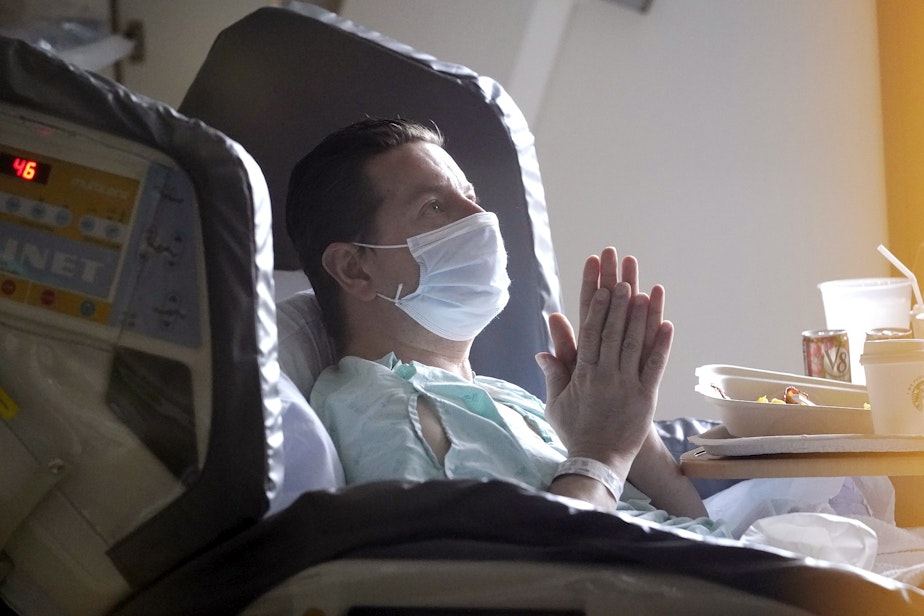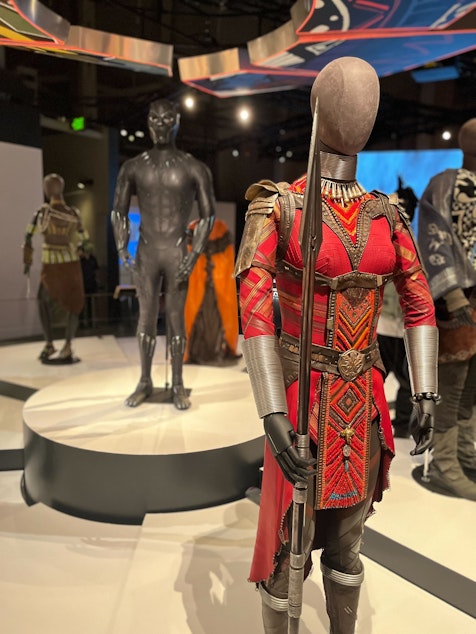Crisis in our 'health care continuum': Today So Far

- Harborview Medical Center is at 130% capacity. Why?
- A new energy source for this Snohomish County PUD.
- Get ready for some more high temps coming our way.
This post originally appeared in KUOW's Today So Far newsletter for August 18, 2022.
Am I the only one who thinks it's a big red flag when Harborview Medical Center starts saying it needs help?
Headlines broke last week that Harborview is at 130% capacity. Dr. Steve Mitchell, medical director of Harborview's Emergency Department, tells KUOW's Seattle Now that "staffing, staffing, staffing" is the root cause of the issue.
"This is, frankly, a new adventure for us; we've never been this high before," Dr. Mitchell said.
Ambulances cannot unload some patients because there's no room for them in the Emergency Department. That department is stalled because there are no beds to move patients into. Many of those patients could be moved to other facilities, where they can get longer-term care, but there is no room at those facilities. And on it goes.
"It's staffing in all parts of the health care continuum," Mitchell said. "...it starts when people call 911 and ask for a medic unit or an ambulance, it continues with hospitals. And importantly, this is where the primary bottleneck is today — what is referred to as the 'post acute care setting' — Harborview right now has 100 patients who no longer require hospitalization ... but we can't release them. They need that next level of care. They need help with various things ... but patients are unable to provide for themselves, or they need help with medications, or they need help with physical therapy."
The result is that a lot of care at Harborview is actually being done in the waiting room. Patients are being placed in hallways and in what used to be office spaces. Some ambulances are being turned away, Mitchell said.
Harborview Medical Center is a level 1 trauma and burn center. It's our region's disaster control hospital. Patients are flown in from as far as Alaska and Montana. So if a problem gets so big that Harborview is strained, that says something. At the heart of the issue are difficulties with staffing, at the hospital and other medical facilities in the area.
Dr. Mitchell notes that Harborview experienced 40% turnover last year. That means it's hiring as fast as it can, and new recruits for its front line are still getting up to speed. The strain is falling largely on front line nurses and technicians.
"What we've been seeing, unfortunately, our nurses are leaving and choosing ... less stressful positions, in a lower acuity clinic," Mitchell said. "And then we are seeing a larger number of retirements than we've ever seen before as well."
Smell that? Snohomish County is getting energized.
Soundside reports that the county is turning to a renewable energy source that is not often talked about. This is how it basically works. Farms produce waste (manure and food scraps). That waste is heated up to produce a liquid and methane gas. Anybody who has composted their waste is aware of how this works, and of the compost perfume that is produced (methane doesn't actually smell too much, but this is manure we're talking about). The methane can be burned as fuel, and the liquid goes right back into the farm as fertilizer. Small versions of this have been happening among Snohomish farms and the Tulalip Tribe over the years. Now, a county PUD is upscaling with a generator that has the potential to power 675 homes.
If this sounds familiar, it's how Tina Turner powered the Thunderdome. Methane can work pretty well as a fuel, at least, until we invent Mr. Fusion and can put our waste in that. Closer to reality, I once toured a sewage processing facility outside of Portland where they were capturing methane to burn as fuel and supplement their energy needs. They were also producing biosolids, which are used to fertilize crops. So the idea isn't entirely new. But as we look for alternative forms of energy, our everyday waste could provide one solution. Any enterprising HOAs out there might want to look into this to cut down on costs.
One last thing, in case you haven't been following the forecast — we have another heat wave coming to the Northwest. Things will cool down a little bit over this weekend, but the high temps will return next week.
Also from KUOW's newsroom:
- Seattle banks on hiring bonuses to draw new police recruits
- 'Another kind of homophobia:' Critics say King County's monkeypox vaccine criteria are intrusive
And more updates in KUOW's Today So Far blog!
AS SEEN ON KUOW

The costumes for "Black Panther" drew heavy inspiration from a variety of tribal techniques and patterns, all of which design the visual aesthetic of the futuristic Wakanda. These costumes are part of MoPOP's latest exhibit, "Afrofuturism in Costume Design," featuring the work of Ruth E. Carter. (Mike Davis / KUOW)
DID YOU KNOW?
Yesterday, I made a passing joke about the "aroma of Tacoma." Those of us who grew up around these parts may be familiar with the phrase, and a certain smell that lingered around while driving along I-5 through Tacoma.
What I love about the "aroma of Tacoma" is that the source is different depending on who you ask. Some say it was the old paper/pulp factory, a meat rendering plant, the fossil fuel refinery, or simply Commencement Bay in the sun at low tide.
A lot of cities have a smell to them, for better or worse. Tacoma, however, has a freeway laid out alongside a few sources. I recall my grandfather's old shop in Portland's Pearl District, before they called it the "Pearl District," when is wasn't so pearly. There was a butcher shop, or a meat processing plant, or something like that, and you definitely knew it by the smell. I'm sure folks were aware of a Portland perfume while driving on the 405. And whenever I drove past the Olympia brewery, when it was operating, there was certainly an Olympia odor in the air.
But "Tacoma" and "aroma" just sounds pretty nice together, the city has a massive freeway with a lot of cars running through it, and those cars have generally been in a traffic jam over the past few decades. So I figure folks have plenty of time to ponder the aroma of Tacoma.
ALSO ON OUR MINDS

Meet this year's child Mullet Championship finalists
Call it a Kentucky Waterfall, a Tennessee Top Hat or a Missouri Compromise, at the end of the day it's the same iconic haircut: the mullet. And now fans of the business in the front, party in the back hairdo have a chance to vote on their favorite styles in this year's USA Mullet Championship.
Note from Dyer: I post this story as a reminder to us all that, despite all the crap in this world, the internet can sometimes be a force for good.

